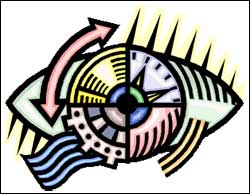The Dual Functions of Sight – Perception and Action – Demonstrated for First Time

illustration of eye
The dissociation in the visual system between two separate functions – one that enables us to identify objects and the other to interact with them – has been clearly demonstrated for the first time in healthy humans by researchers at the Hebrew University of Jerusalem.
These separate vision-related actions have been documented from the beginning of the 20th century in patients who suffered damage to the visual system as a result of illness or injuries in which one or the other function – identification or action – was damaged.
For example, persons suffering from ataxia are able to verbally identify an object presented to them but have difficulty in grasping it, while those who have agnosia can grasp an object if handed to them but are unable to name or indicate the position, size or texture of the object.
This dissociation between action and perception suggests the existence of two separate visual streams However, despite the wide research triggered by this theoretical concept, it had not been proved in subjects in whom both streams are functioning normally.
Now, through the use of functional magnetic resonance imaging (fMRI), Prof. Ehud Zohary and his graduate student Lior Shmuelof of the Department of Neurobiology at the Alexander Silberman Institute of Life Sciences at the Hebrew University have been able to demonstrate dissociation between perception of objects and actions in the brains of healthy persons. An article detailing their findings was published as the cover story in the journal Neuron.
In the article, the researchers described how they were able to observe dissociation between dorsal and ventral activation patterns in the brains of participants who were shown video scenes of objects and actions directed towards those objects.
What Shmuelof and Zohary saw in the fMRI images were that a complex in the occipito-temporal cortex area of the brain responded to the identity of an object presented on the screen, while a different complex in the parietal lobe region reacted when the subjects were shown actions directed at those objects.
The researchers point out that the areas of the brain responsible for motor action were activated when the experimental subjects were shown scenes of action, even though the subjects were in a passive state, viewing only video clips presenting actions by others, and were not involved in any way with the activities being screened.
What this suggests is that there is an interrelationship between guiding of our own actions and understanding actions taken by others – a kind of “stepping into another’s shoes” that may be one of the bases underlying social communication.
Media Contact
More Information:
http://www.huji.ac.ilAll latest news from the category: Health and Medicine
This subject area encompasses research and studies in the field of human medicine.
Among the wide-ranging list of topics covered here are anesthesiology, anatomy, surgery, human genetics, hygiene and environmental medicine, internal medicine, neurology, pharmacology, physiology, urology and dental medicine.
Newest articles

Properties of new materials for microchips
… can now be measured well. Reseachers of Delft University of Technology demonstrated measuring performance properties of ultrathin silicon membranes. Making ever smaller and more powerful chips requires new ultrathin…

Floating solar’s potential
… to support sustainable development by addressing climate, water, and energy goals holistically. A new study published this week in Nature Energy raises the potential for floating solar photovoltaics (FPV)…

Skyrmions move at record speeds
… a step towards the computing of the future. An international research team led by scientists from the CNRS1 has discovered that the magnetic nanobubbles2 known as skyrmions can be…





















